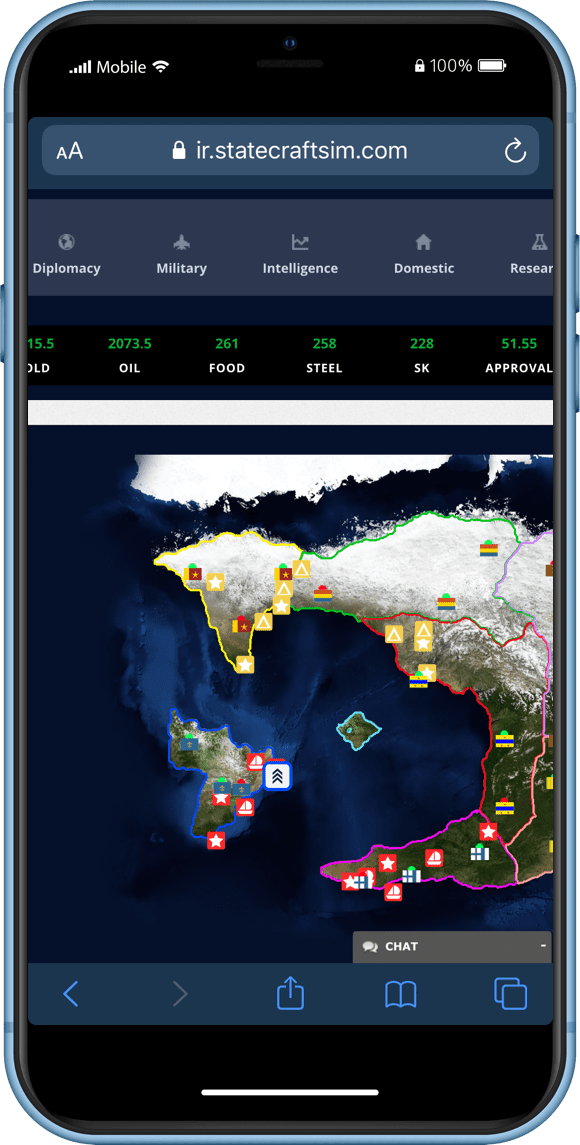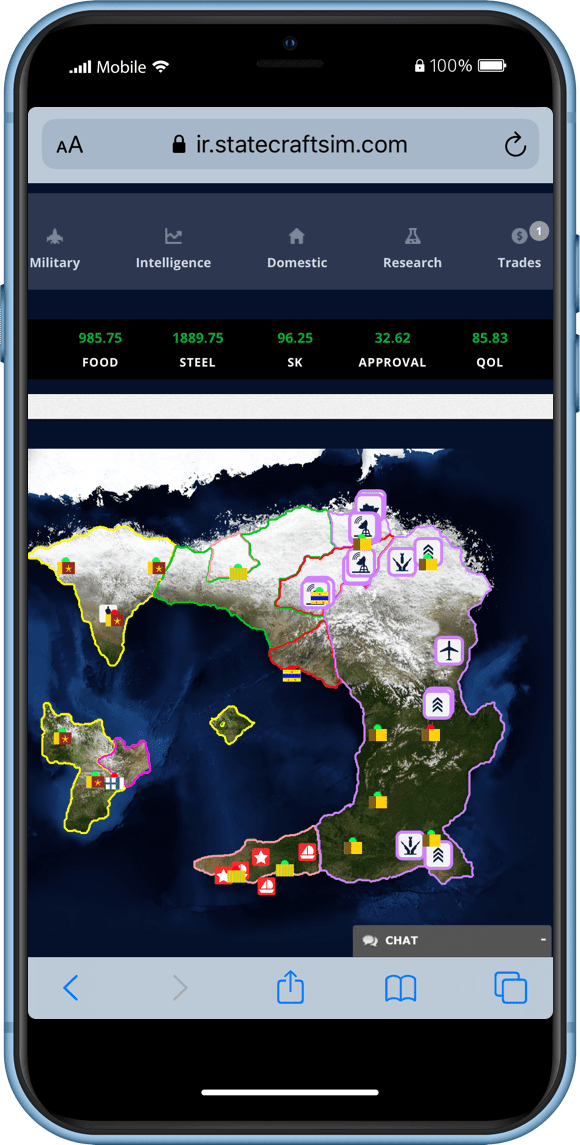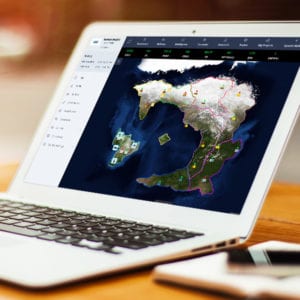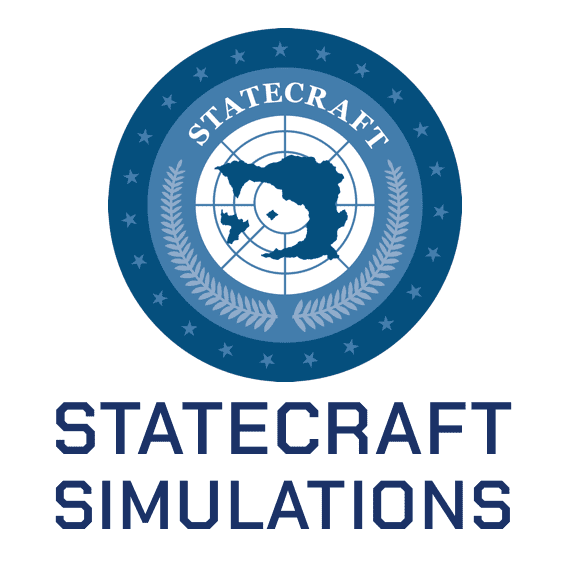Introduction to International Relations Edition
Statecraft International Relations offers an immersive, student-driven simulation that dynamically adapts based on student decisions, effectively illustrating over 50 core course concepts. In this simulation, students take the helm, determining their nation’s governmental structure, economic policies, and political systems while navigating through global challenges such as humanitarian crises, terrorism, environmental issues, and security dilemmas. Each week, participants engage in critical decision-making concerning international trade, economics, human and national security, shaping their simulated world in real-time through their actions. This interactive platform not only enhances learning by providing a practical application of theoretical concepts but also significantly reduces instructors’ workload by an average of 13%.
The Statecraft International Relations Simulation is a great addition to an Introduction to International Relations Course and covers over 50 topics along with the essentials of International Relations Online textbooks.
The Statecraft IR Simulation is a great addition to an Introduction to International Relations Course and covers over 50 topics along with the Essentials of International Relations Education Online textbooks.
Length of Simulation & Class Time
The IR Simulation runs for a default 7 to 10 weeks with each week being considered a “turn” (many instructors choose to run the sim for 12 or even 15 weeks, this is completely up to you and no extra charge to extend your simulation).
Note: A rule of thumb when scheduling turns is that each one requires about 1.5 to 3 hours of work from the students.
Turn 0 is a Tutorial week for students to establish a basic understanding of the simulation and set up their countries. The sim runs live 24/7 which allows for maximum convenience for both instructors and students to cut deals and make decisions on their own time. We recommend establishing a 7 day per Turn schedule and having at least one day per week where you encourage students to negotiate, hold international negotiations, and even make speeches defending their countries’ actions on various global issues.
Note: We recommend not telling your class how many Turns the simulation will last as students can act unrealistically and unpredictably when they know they are on the final turn.
Alternative Schedule Formats
Tapered turn schedules: If you want to run the full simulation within 4 weeks you can use the tapered turn schedule model by decreasing the length of each turn by one day until you have just two days per turn. It is recommended to contact support at [email protected] for assistance and guidance on this setup. This great for summer, winter, or shorteneded semesters!
One day sim: If you want to run the simulation in one day you only need 30 minutes between turns. In a format like this you would schedule an all day play through with students on a saturday or sunday from 8 AM to 5 PM with a lunch break. It is recommended to contact support at [email protected] for assistance and guidance on this setup
What Happens During a Turn
The simulation automatically groups students into countries based on the Foreign Policy Attitude Survey they take during the signup process. During Turn 0 students vote for their President, name their country and cities, and choose their government type and attributes.
Every week students are given a checklist and walkthroughs of their screen to guide them in achieving their goals and interacting with other countries. At the beginning of each Turn, students receive news messages with updates on major events and situations unfolding in their simulation. Instructors can also find these under “News” on the top of the instructor dashboard.
From here they will start making decisions about trade, country development, domestic politics, economics, the environment, and national security. All of their choices are cancellable until the turn ends. Once the turn ends the simulation will calculate the impact of all student choices and start the next turn with new world conditions and unfolding sim events.
Suggested Base Knowledge of Students
No base knowledge is required, however, to maximize the learning experience for students, we recommend the simulation start after covering the basics of the course for at least a few weeks. Since the sim normally runs for 7-10 weeks, earlier course concepts may help in cementing actions within the sim.
The Statecraft IR Simulation is a great addition to an Introduction to International Relations Course and covers over 50 topics along with the essentials of International Relations Online textbooks.
Class Assignments
Many instructors get creative with how they connect classroom assignments to the simulation. These may be a good fit for your class:
- Memos: Instructors can provide students with a list of memo prompts that help students tie their simulation experience to course topics.
- Debrief Presentation: This is a guided debrief that helps students reflect on the key moments that unfolded throughout the simulation. This allows them to “reveal their cards” and openly explain their perspectives and actions from a 360 degree perspective. It is a great opportunity to encourage students to use their memos as historical references in creating a comprehensive presentation that they give to the rest of the class. Some classes have formalized this presentation and made it public to a larger audience. Watch students from The Çağ University in Turkey present their debrief to an auditorium of people!
- Debrief Paper Assignments: A paper to go along with the Debriefing Presentation that goes more in depth on how the debrief topic unfolded during the simulation.
Student Engagement Tracking
To keep track of students decisions, there are multiple tools for instructors to utilize:
- The toggle option at top left of the map gives instructors a visual display of countries’ international attitudes and actions involving trade, diplomacy, conflict, and country development. The map is populated with country development rings surrounding capital cities along with colored arrows that indicate an array of collaborative and aggressive actions. Instructors can click on them to “drill down” for specific details about each action and country interaction.
- Weekly emails go straight to the instructor inbox and give an overview of sim events, country attitudes and general actions, and a students’ engagement report.
- Reading at least one memo from each country during each week can be a great way to understand how students perceive what is happening and how they currently feel about other countries and simulation events. You can even change the memo topic for each week based on the things you would like to better understand from the student perspective
- Instructors can also log into each students’ dashboard and read their messages to see which peers a student may be interacting with.
Grading
The following grading criteria is a basic recommendation and can be customized to fit your classroom needs.
- 5% – Simulation Performance: Students’ simulation performance score is based on the accumulation of points through the achievement of collective goals, competitive goals, and the best average Quality of Life scores.
- 5% – Role Research Assignment: Students research the roles and submit an assignment that include their role including description, duties, why they are interested in each role, and a historical example
- 10% – Simulation Participation: Students are prompted to take two Manual quizzes during Turn 0 and Turn 1 which can be used as part of the participation grade. Students can connect the course materials more meaningfully to their class by writing weekly memos. Students are also prompted to rate the level of influence of exceptional peers in the simulation. You can add this Sim Participation, Sim Performance, or consider giving it as extra credit for anyone who receives it.
- 15% to 30% – Paper or Debriefing Presentation: The paper or debriefing presentation requires you to integrate your simulation experience with a variety of course concepts.
- 10% – 25% – Debriefing Paper – a paper that accompanies the debriefing presentation over the same topic. Students turn in their paper after they debrief the class on their chosen topic.
Sample Syllabus – Example of how Statecraft has been incorporated into an intro to IR class
Debriefing Assignment – The following “debriefing questions” are designed to illuminate, for the entire class, key concepts that may be experienced more directly by some students than others.
Student Gameplay Summary – Brief run through of the gameplay from the student perspective
Tying Statecraft to Lectures – These lecture outlines cover topics that are commonly included in international relations and global politics courses. They provide suggestions for how the instructor can use examples from students’ experiences in Statecraft to illuminate key concepts and theories
Get started today to experience how Statecraft brings International Relations to life in your course!
You can sign up online now to get started immediately or book your personal demo! We’ll give you a complete product tour, answer all of your questions and help you configure your first Statecraft IR Simulation.
Student map interface
The Statecraft World Map, a pivotal component of the Essentials of International Relations Edition and Introduction to International Relations Online Textbooks, serves as an interactive simulation where students dive into the intricacies of global diplomacy and strategy. Accessible via desktop or mobile devices, this map brings to life the geographical intricacies of the simulated world, showcasing resource centers, deserts, mountains, and the prevailing climate conditions. Colored lines outline the territorial boundaries of each country, while icons indicate the locations of cities, military units, landmarks, and areas under terrorist control. As students engage in espionage against foreign nations, these icons reveal hidden details, offering a deeper understanding of the geopolitical landscape.
By exploring the nav bars situated at the top of the interface, participants gain comprehensive access to vital information shaping their virtual world. This includes intelligence data on other countries, enabling students to strategize their next moves in the realms of Diplomacy, Military operations, Intelligence gathering, Domestic policies, and Research development. Additionally, they can efficiently manage their Resources, ensuring their nation thrives in this dynamic simulation. The detailed legend key further aids navigation, making the Statecraft World Map an essential tool for mastering the complexities of International Relations.
Diplomacy
- Build International Organizations
- Collaborate to solve global issues like climate change, world hunger, terrorism, and human rights
- Construct Treaties
- Exchange Ambassadors
Military
- Enhance military technological capabilities
- Strategically build their national defense strategy
- Build and maintain a navy, air force, and army
- Forge collective security alliances
Intelligence
- Spy on other countries' domestic politics, economy, and military capabilities
- Build counter-intelligence capabilities to limit spying in their own country
- Run covert operations to sabotage and undermine other countries

Domestic
- Enhance your Citizens' Healthcare and Unemployment System
- Improve your Justice System and Environment
- Invest in Public Education and University Systems
- Foster your country’s unique culture and gain tourism points!
Research
- Gain new, powerful technologies that can enhance domestic ratings such as health, safety, the environment, or improve national security
- Trade technologies with other countries to more rapidly develop their Quality of Life and National security
Resources Bar
- Manage economic resources
- Budget for enhancing domestic infrastructure or security
- Trade with other countries and develop relationships with countries that produce needed resources
Strategy
To gather points students can pursue a myriad of strategies: from avoiding conflict for domestic wellbeing to cautiously collaborative strategies that maximize economic synergies while carefully checking other countries' imperial motives. It is possible that every country could get a perfect score and all thrive; however (just like in the real world) that rarely happens.
Goals
Each turn students try to achieve three types of goals: (1) Cooperative Global Goals that are shared with the entire world such as ending world hunger; (2) Competitive Country Goals for excelling in a certain area such as “Most Environmentally Friendly” or “Safest” and finally (3) Country Development Goals based on domestic factors such as citizens' health, welfare, environment, safety and education.
Domestic Factors
Every turn countries will produce resources students must decide how to invest; they’ll bump up against the classic “guns vs. butter” conundrum. They’ll also get a Quality of Life score that equates to points for their citizens' health, welfare, environment, safety and education. Unhappy citizens engage in costly strikes and demonstrations! Unhealthy citizens die of famine!
International Factors
There are pirates terrorizing the world! Ice Mountain is melting and threatening to flood the entire globe! Should they participate in the U.N.? What about that crazy country over there trying to build a nuclear weapon? Both simulation events and classmates create drama and excitement and demonstrate how intertwined the world truly is.
Statecraft IR, an integral part of the Essentials of International Relations and Introduction to International Relations Online Textbook, crafts scenarios where students don’t just learn about course concepts; they live them. This immersive simulation compels students to apply the critical lessons from their International Relations curriculum to navigate complex global issues successfully. As participants encounter real-world challenges such as the security dilemma or the collective action problem within the simulation, they’re met with prime teachable moments that enhance their understanding and engagement with the material.
Statecraft IR is designed to revolutionize your classroom into an immersive, memorable learning adventure, enriching both your teaching experience and your students’ academic journey. Through this dynamic platform, you’re not just teaching about global affairs; you’re providing a firsthand experience of the intricacies and nuances of International Relations, making abstract concepts tangible and understandable. This unique approach ensures that both you and your students will find the learning process as enjoyable as it is educational, cementing key principles of International Relations in a practical, engaging manner.
The Statecraft IR Simulation is a great addition to an Introduction to International Relations Course and covers over 50 topics along with the essentials of International Relations Online textbooks.
Course concepts covered
The multidimensional International Relations Simulation program, a core component of the Essentials of International Relations Edition and Introduction to International Relations Online Textbooks, intricately covers over 50 course concepts within major IR sub-categories. Engaging with this simulation opens up unprecedented opportunities to illustrate the dynamic application of theoretical knowledge, bringing to life the rich tapestry of global affairs. Students don’t just learn about International Relations; they experience its complexities and challenges firsthand, enhancing their engagement and fostering the development of personal insights into global issues.
Instructors integrating this simulation into their curriculum report significant enhancements in teaching efficacy, noting the ability to conduct more productive lessons and engage in more meaningful conversations with students. By providing a vivid, interactive backdrop for exploring International Relations, the simulation facilitates a deeper understanding of key concepts, making abstract theories tangible and relatable. This immersive approach not only captivates students’ interest but also encourages them to critically analyze and discuss the real-world implications of the course material, enriching the educational experience for both students and educators alike.

Global Environmental Politics
Levels of Analysis
International Political Economy
Two Level Games
International Security
Globalization
Theoretical Perspectives
Human Rights
Human Security
Terrorism
Foreign Policy
Alternative Theoretical Perspectives
effective, fun & helpful

Demonstrate Course Concepts
Students experience Introduction to International Relations essentials and 50+ concepts such as the security dilemma and the collective action problem first-hand and personally feel how complicated foreign policy and country management truly is. In order to succeed in the simulation, they’ll have to apply course-related knowledge.

Engage
Students
Game-like play sucks students into the simulations where they must take ownership of their learning experience. They’re empowered to excel to their own personal limits and shine. Engagement enhances the knowledge acquisition process and makes it fun!

Save Time
The simulation is easy to set up and runs itself. You have a new tool to draw connections to course concepts and spark dynamic conversations. All-unique simulation scenarios every semester promote academic honesty. Instructor tools do tasks like grading for you and the simulation fits seamlessly with any Introduction to International Relations Online Textbook.
The Statecraft IR Simulation is a great addition to an Introduction to International Relations Course and covers over 50 topics along with the essentials of International Relations Online textbooks.
how Statecraft ir works
Easy Set-up & Launch
- Easily adaptable for small classes under 20 students or for large classes up to 600 students running multiple worlds; each world will have six to 108 students (Statecraft was originally designed and tested for a class of 180 students)
- Run through an easy 3-minute configuration and get the code for students to activate their simulation
- When students sign up with the code they’ll pay for the simulations unless you selected to pay as an organization.
- The Foreign Policy Attitude Survey automatically groups like-minded students together into countries when they sign up, ensuring variation in countries’ views and policy approaches
- You set the start date plus the number and duration of the “turns”; commonly teachers launch the simulation in the third week of the semester and run it for seven to 10 turns/weeks, however you have complete control to set the optimal timing based on your class needs and schedule
- There will be six to 12 countries in each world with up to nine roles per country
- Students receive a comprehensive instruction manual and their first quiz asks key questions from the manual to make sure they understand how to play
- During the preparatory “Turn Zero” students configure their country and personal roles

The Statecraft IR Simulation is a great addition to an Introduction to International Relations Course and covers over 50 topics along with the essentials of International Relations Online textbooks.
4.72
out of 5 stars
Instructors rated Statecraft Customer Service 4.72 of 5 stars User Satisfaction Surveys
Excellent Customer Support
- You have help at every step of the process: from set-up to implementation with quick assistance for any questions you have along the way
- Both you and students can reach out to us directly at any time
- Our customer support is available 7-days a week from 7am to 11pm; we try to answer fast and always get back to you within 24 hours
- We’ll take care of students' technical questions so that you just handle the political questions
- Teachers who reach out and ask questions report some of the best overall simulation class experiences, so we highly encourage you to contact us!
Reasons the Statecraft IR Simulation is so effective:
- An innovative way to teach concepts beyond traditional lectures that fits with any Introduction to International Relations Online Textbook
- Concepts become personal and experienced by students
- Students are engaged and participating both inside and outside of class
- Engagement enhances the knowledge acquisition process
- Students take ownership of their experience and are empowered to shine
- Teaches career skills like leadership, teamwork, negotiation and strategic thinking that help them become more employable
- Students must apply course knowledge and do context-based problem solving to succeed
- Working in teams on common goals fosters student collaboration and relationship building even in large lecture classes.

The Statecraft IR Simulation is a great addition to an Introduction to International Relations Course and covers over 50 topics along with the essentials of International Relations Online textbooks.
Statecraft Project LeaderMaker
As a company, we are passionate about student success! Our mission is to engage students in social science topics in a way that ignites their curiosity, excitement for learning, and social skills regardless of their learning styles or socio-economic disadvantages. In the spirit of this mission, we founded the Statecraft Project LeaderMaker, which donates simulation accounts to low-income high schools.
How it works:
- Colleges use Statecraft Simulations in social science classes
- Statecraft donates simulation accounts to low income high schools
- At-risk students are reengaged in school and gain employability skills
- More students graduate high school with leadership and employment skills
The number of accounts donated is determined by evaluating school’s free lunch percentage and unique budget constraints. Contact Joe at [email protected] to learn more about the program.

The Statecraft IR Simulation is a great addition to an Introduction to International Relations Course and covers over 50 topics along with the essentials of International Relations Online textbooks.
Let's Keep In Touch
Sign up for the Statecraft Newsletter and we’ll send you product updates, simulation tips and exclusive offers straight to your inbox!
The Statecraft IR Simulation is a great addition to an Introduction to International Relations Course and covers over 50 topics along with the essentials of International Relations Online textbooks.

